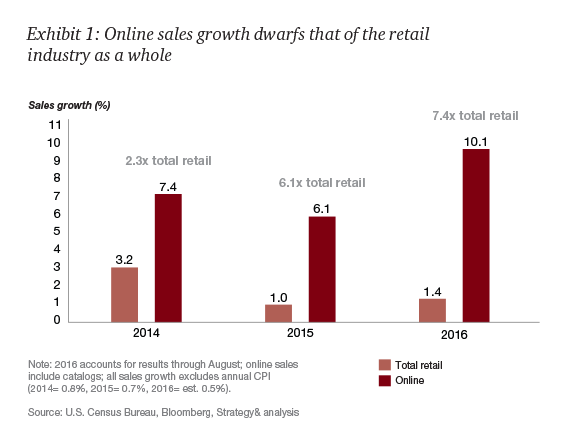In spite of what you may have heard, not every retailer is selling online, not every physical store is closing, and some successful brick-and-mortar shops have real concerns about getting started in ecommerce.
There are many examples of successful brick-and-mortar-only retail stores. Just look around in your neighborhood. There is probably a successful independent pet supply store, a local hardware chain, and a few shops selling car audio systems or truck tops.
These companies may serve their communities, offer a good value, and take great care of their customers. But they are not yet offering an omnichannel customer experience. And they may have valid concerns about ecommerce and omnichannel retailing.

There are many successful brick-and-mortar retail business that are not yet selling online. Some of these stores may be uncertain how to get started with ecommerce, or they may have valid concerns about how ecommerce will impact their business. Image: Mike Petrucci.
Concerns about Ecommerce
“Omnichannel strategies — which seamlessly synchronize many forms of customer experience, including brick-and-mortar store environments, online sales, smartphone connectivity, and voice connections — have been a success for a few retailers,” wrote Nick Hodson, Christopher Perrigo, and Douglas Hardman in Strategy&, a journal from PwC, the professional services firm.
“Generally speaking, though, these efforts have not succeeded in arresting declines in store activity, improving retailer profitability, or boosting online sales. Although many traditional retailers today highlight the healthy growth rate of their online sales, most are actually lagging behind and losing market share to Amazon and other online specialists.”
There is a sense in which ecommerce is easier for either very large enterprise retail businesses or very small online-only sellers than it is for midmarket companies with established physical stores.
To paraphrase “The Karate Kid,” the movie, when you’re walking down the road, you can safely walk on the left side or on the right side, but if you walk down the middle of the road eventually you get squashed like a grape.
There is a sense in which this applies to ecommerce.
A small ecommerce retailer can have a short path to profitability. For a new, pure-play ecommerce business, inventory can be kept in a garage, a storage unit, or with a third-party fulfillment service. Overhead is low.
The company will likely choose a SaaS ecommerce platform that costs less than a couple hundred dollars per month. There is almost a straight line between search engine optimization, pay-per-click advertising, and profit. A sole proprietor and a small number of employees are fully engaged in ecommerce, and just a few sales will generate a profit.
In short, small ecommerce businesses have relatively low overhead and are built to sell online.
Conversely, there are large enterprise retailers like Target and Walmart. These companies are able to invest hundreds of millions of dollars into ecommerce-specific employees, warehouses, and software. They have the vast resources to build successful omnichannel customer experiences. Enterprise sellers can also endure losses while their online sales grow.
And there are the companies in the middle.
A midmarket brick-and-click retailer doesn’t have the low overhead and focus found in a small ecommerce operation. It does not have the resources of an enterprise business, to hire ecommerce employees, buy software, or sustain losses while sales ramp up.
It has to figure out how to add ecommerce to everyone’s job. It needs to find efficiencies so a marketing employee focused on circulars can also figure out Facebook ads, so the IT manager maintaining the store’s point-of-sale system can also choose an ecommerce platform, and so the logistics manager can receive goods, stock stores, and ship directly to customers.
It is little wonder some retailers have concerns about adding ecommerce.
Ecommerce Is Imperative
Nonetheless, adding ecommerce is imperative. In 2016, online sales grew about 10 percent, while overall retail sales grew about 1.4 percent. Thus retail ecommerce is growing almost seven and a half times faster than the industry average.

PwC reported that ecommerce sales growth at 10.1 percent in 2016 is significantly outpacing overall retail sales growth of 1.4 percent.
For at least some brick-and-mortar business, adding an online sales channel will drive the company’s future growth.
For example, there is a regional, Midwestern retail chain with 100 brick-and-mortar stores. The company launched an ecommerce business a few years ago, and now online sales are about two-and-a-half times the sales of the company’s best performing physical store, at a similar margin. What’s more, the company uses online sales to guide its choice of new physical store locations and uses ecommerce to test new product lines.
Therefore, the question is not whether to add ecommerce. Rather, it’s how to get started successfully in ecommerce. What follows are five ways a brick-and-mortar retailer can ease into online sales.
5 Ways to Get Started
Offer click-and-collect. Shipping is expensive and difficult for some brick-and-mortar retailers. You need to invest in packing materials. Buy a scale. Find space in a warehouse and hire personnel to ship. You will need to negotiate shipping rates, and be able to lose money on some shipments to start customer relationships.
Or you can ease into ecommerce and just offer click-and-collect, wherein customers can order items online and have those items waiting for them at the store. You might even start with “selected” products, and then add more options as your company executes better.
Ship from store. No space in your warehouse? Don’t want to keep separate inventory for your online sales? Try shipping from a store.
Choose one of your best-managed stores and create a small ecommerce workstation in the stockroom. Equip it with boxes, a label printer, and everything else you need to ship.
The store and its manager should get credit for each ecommerce sale.
Offer subscription services. Subscription services can be a terrific business model for online sales. Your store won’t necessarily have to compete with the likes of Amazon or Walmart. Customers don’t expect fast shipping, and you can focus on just a few products.
Many inexpensive ecommerce platforms can have your business up and running with subscriptions quickly and inexpensively.
Drop ship. Many of the suppliers your store buys from now will be happy to ship directly to customers on your behalf.
For example, a store that carries Berne work wear can ask Berne to fulfill online orders. The order comes in from the retailer’s website and Berne packs and ships it directly to the customer.
Similarly, an independent pet store that buys from Phillips Pet Food & Supplies, a distributor, can use Phillips’ Endless Aisle program or its Shopify plugin to submit online orders that Phillip’s Phido division will fulfill.
Sell on marketplaces. If you’re concerned about disappointing customers with a poor experience whilst you learn the ins-and-outs of ecommerce, try starting on a marketplace like Amazon.
You can select just a couple of products to sell, and learn what it takes to manage an ecommerce business before you start selling on your own site.





